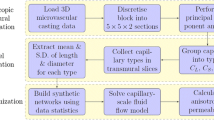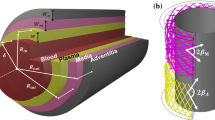Abstract
The coronary capillary flow is analyzed theoretically based on the laws of continuum mechanics. The capillary is considered as a long, elastic and permeable vessel loaded externally by tissue pressure. It is subjected to periodic length changes, together with adjacent myocytes. Capillary flow is driven by arteriolar-venular pressure differences. Ultrafiltration due to transmural hydrostatic and osmotic pressure gradients is included in the model. Consideration of mass conservation leads to a nonlinear flow equation. The results show that under stable physiological conditions ultrafiltration is of minor importance. The analysis of untethered capillaries predicts regional differences in capillary flow. In all regions, but more so in the subendocardium, capillaries undergo significant periodic volume changes, giving rise to intramyocardial pumping. In the deeper layers, capillary wall elasticity is of major importance. In the subepicardium, the possible capillary length-changes with adjacent myocytes tend to enhance systolic/diastolic volume differences. The predicted patterns of the overall capillary flow in the left ventricular (LV) wall are in good qualitative agreement with measured coronary phasic flow, showing systolic retrograde arterial inflow, accelerated venal outflow, and diastolic rapid filling accompanied by venal retrograde flow. Analysis of the flow in tethered capillary shows significant effect of the collagen attachments between the surrounding myocytes and the capillary wall. The advantage of the continuum analysis is demonstrated in the present study by its ability to elucidate and evaluate the role of flow controlling mechanisms and their complex interactions.
Access this chapter
Tax calculation will be finalised at checkout
Purchases are for personal use only
Preview
Unable to display preview. Download preview PDF.
Similar content being viewed by others
References
Chilian WM, Marcus ML. Phasic coronary blood flow velocity in intramural and epicardial coronary arteries. Circ Res 1982; 50: 775–781
Hoffman JIE, Spaan JAE. Pressure flow relations in coronary circulation. Physiological Rev 1990; 70: 331–390
Hoffman JIE, Baer RW, Mandey FL, Messina LM. Regulation of transmural myocardial blood flow. ASME Trans J Biomechan Eng 1985; 107: 3–9
Levy BI, Samuel JL, Tedgui A, Kotelianski V, Marotte F, Poitevin P, Chadwick RS. Intramyocardial blood volume in the left ventricle of rat arrested hearts. In: Brun P, Chadwick RS, Levy BI (eds) Cardiovascular Dynamics and Models (Colloque INSERM 183). INSERM: Paris, pp 65–71, 1988
Spaan JAE. Coronary diastolic pressure-flow relation and zero flow pressure explained on the basis of intramyocardial compliance. Circ Res 1985; 56: 293–309
Dinnar U. Interaction between intramyocardial pressure and transcapillary exchange: A possible control of coronary circulation. In: Sideman S, Beyar R (eds) Simulation and Control of the Cardiac System, CRC Press: NY, pp 109–130, 1987
Schmid-Schonbein GW, Lee SY, Sutton D. Dynamic viscous flow in distensible vessels of skeletal muscle microcirculation: application to pressure and flow transients. Biorheology 1989; 26: 215–227
Chadwick RS, Tedgui A, Michel JB, Ohayon J, Levy BI. Phasic regional myocardial inflow and outflow: comparison of theory and experiments. Am J Physiol 1990; 258: H1687–H1698.
Bassingthwaighte JB, Yipintsoi T, Harvey RB. Microvasculature of the dog left ventricle myocardium. Microvasc Res 1974; 7: 729–249
Berne RM, Rubio R. Coronary circulation. In: Handbook of Physiology - The Heart (section 2/1). Am Physiology Soc:MD, 1979; pp 873–952
Caulfiled JB, Borg TK. The collagen network of the heart. Lab Invest 1979; 40: 364–372
Ellis CG, Mathieu-Costello O, Potter RF, MacDonald IC, Groom AC. Effect of sarcomere length on total capillary length in skeletal muscle: In vivo evidence for longitudinal stretching of capillaries. Microvasc Res 1990; 40: 63–72
Poole DC, Batra S, Mathieu-Costello O, Rakusan K. Capillary geometrical changes with fiber shortening in rat myocardium. Circ Res 1992; 70: 697–706
Chadwick RS. Slow viscous flow inside a torus. The resistance of small tortuous blood vessels. Quart Appl Math 1985; 43: 317–323
Lipowsky HH, Kovalcheck S, Zweifach BW. The distribution of blood rheological parameters in the microcirculation of cat mesentery. Circ Res 1978; 43: 738–749
Skalak TC, Schmid-Schonbein GW. Viscoelastic properties of microvessels in rat spinotrapezius muscle. ASME Trans J Biomech Eng 1986; 108: 193–200
Fibich G, Lanir Y, Liron N. Mathematical model of blood flow in a coronary capillary. Am J Physiol 1993; accepted for publication
Ono T, Shimohara Y, Okada K, Irino S. Scanning electron microscopic studies on microvascular architecture on human coronary vessels by corrosion casts: Normal and focal necrosis. Scanning Electron Microvasc 1986; 1: 263–270
Boseck GL. Transcapillary fluid exchange in rat spinotrapezius muscle. Ph.D. Thesis. Univ of California: La Jolla, CA, 1983
Baldwin A, Gore RS. Simultaneous measurement of capillary distensibility and hydraulic conductance. Microvasc Res 1989; 38: 1–22
Ruch TC, Patton HD. Physiology and Biophysics. WB Saunders Co: Philadelphia, 1966
Hargens AR. Interstitial fluid pressure and lymph flow. In: Skalak R, Chien S (eds) Handbook of Bioengineering. McGraw-Hill:NY, pp 19.1–19.25, 1987
Tillmanns H, Steinhausen M, Leinberger H, Thederan H, Kubler W. Pressure measurements in the terminal vascular bed of the epimyocardium of rats and cats. Circ Res 1981; 49: 1202–1211
Chilian WM, Layne SM, Klausner EC, Eastham CL, Marcus ML. Redistribution of coronary microvascular resistance produced by dipyridamole. Am J Physiol (Heart Circ Physiol 25) 1989; 256: H383–H390
Klassen GA, Armour JA, Garner JB. Coronary circulatory pressure gradients. Can J Physiol Pharmacol 1987; 65: 520–531
Solti F, Jellinek H. Cardiac Lymph Circulation and Cardiac Disorders. Akademiai Kiado: Budapest, 1989
Nevo E, Lanir Y. Structural finite deformation model of the left ventricle during diastole and systole. ASME Trans J Biomech Eng 1989; 3: 342–348
Kresh YJ. Myocardial modulation of coronary circulation. Am J Phsyiol 1989; 257: H1934–H1935
Borg TK, Caulfield JB. The collagen matrix of the heart. Federation Proc 1981; 40: 2037–2041
Author information
Authors and Affiliations
Editor information
Editors and Affiliations
Rights and permissions
Copyright information
© 1993 Springer Science+Business Media New York
About this chapter
Cite this chapter
Fibich, G., Lanir, Y., Liron, N., Abovsky, M. (1993). Modeling of Coronary Capillary Flow. In: Sideman, S., Beyar, R. (eds) Interactive Phenomena in the Cardiac System. Advances in Experimental Medicine and Biology, vol 346. Springer, Boston, MA. https://doi.org/10.1007/978-1-4615-2946-0_13
Download citation
DOI: https://doi.org/10.1007/978-1-4615-2946-0_13
Publisher Name: Springer, Boston, MA
Print ISBN: 978-1-4613-6280-7
Online ISBN: 978-1-4615-2946-0
eBook Packages: Springer Book Archive




